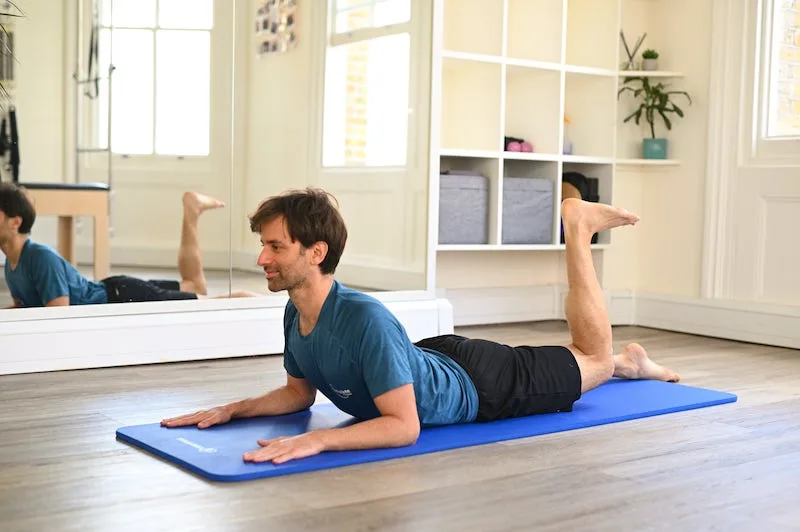When we think of pelvic floor exercises, we typically think of those being just for women, however, pelvic floor exercises for men can be highly effective and beneficial.
As men too can also suffer from pelvic floor dysfunction or weakness.
Many men don’t even think they have a pelvic floor, but you do! The pelvic floor is a sling of muscles 3underneath the pelvis from your tailbone at the back to your pubic bone at the front.
The pelvic floor muscles have a number of different roles;
- supporting the organs within the pelvis (the bladder and bowel)
- working with the deep abdominals, spinal muscles and diaphragm to give you effective core control.

They are always at a level of slight tension to prevent leakage of urine. They need to be able to contract fully when you cough, sneeze or laugh but then also relax fully to allow you to open your bowels and pass urine.
This function of full relaxation and full contraction is important and we see dysfunction of both overactive and under-active pelvic floor muscles in men.
This article will cover the common symptoms, the causes and specifically, pelvic floor exercises for men that can be done at home.
Common symptoms of pelvic floor weakness
- Leaking of urine when you cough, laugh or sneeze (stress incontinence)
- A need to go to the toilet more regularly than normal during the day or night (known as frequency)
- Urgent needs to visit the toilet and leaking before you get there (urge incontinence)
- An inability to control the passing of wind
- Difficulty achieving erection and premature ejaculation
These symptoms can also be a sign of other issues so should always be discussed with your doctor.
Common causes of pelvic floor weakness
- Prostate surgery
Bladder problems are a common side effect of this surgery. Most men will regain bladder control within 12 weeks but doing pelvic floor muscles exercises is key to this. Doing pelvic floor muscles exercises before and after surgery is recommended.
- Surgery for bladder or bowel problems:
This can also have an effect on the continence of the bladder and bowel. Also with any abdominal surgery wounds may affect your abdominals which make up part of your overall core control system with the pelvic floor. pelvic floor and deep abdominal exercises can help to regain this.
- Constipation or straining to empty your bowels:
This can cause a long term strain on the muscles as you are forcing downward pressure on the pelvic floor.
- Long term cough:
This is seen with conditions such as asthma or bronchitis when again the pelvic floor is put under strain for long periods of time.
- Repeated heavy lifting including weights at the gym:
This is due to ongoing strain and downward pressure on the pelvic floor
- Being overweight:
Any increase in weight makes it more difficult for the pelvic floor to control the bladder and bowel as it is already under more load.

3 Pelvic Floor Pilates Exercises for Men
The first thing you need to do is learn where the muscles are and what it feels like when you contract them. The kegel below give you some ideas of how to try that.
It is important to understand that not all men will have the same issues with their pelvic floor muscles. Some men will experience symptoms because they have overactive muscles and some will have underactive. The treatment for these will have a slightly different focus as you may need to concentrate more on the contraction phase or the relaxation phase.
The muscles then need to be able to work with the rest of your body when you move, take part in daily activities and sport. This means that the pelvic floor exercises also need to progress to reflect this.
If you are getting symptoms the best thing to do is to see your GP and then see a pelvic health physio who can thoroughly assess your pelvic floor and give you exercise guidance specific to your needs.
1. Checking pelvic floor muscle action
This is more of a check of awareness of the muscles rather than an exercise. It is not advised to do the urine stream check as an exercise as stopping the flow of urine mid-stream can lead to problems with bladder function.
- Try to stop the stream of urine when standing at the toilet to empty your bladder then start again.
- Alternatively you can stand in front of a mirror with no clothes on. When you contract your pelvic floor you should see your penis draw in and your scrotum lift up. Can you do that without tension in the buttocks, thighs or tummy?
- These will give you an idea of which muscles you need to use to control the pelvic floor.
- Once you have done this try the other exercises below

2. Slow twitch pelvic floor muscle exercises for men
This is a safe pelvic floor exercise for everyone to try. If you have had pelvic surgery of any kind you need to wait until your catheter has been removed but can then start these exercises.
These exercises give the endurance of the muscles to control the bladder and bowel over time, all day, every day.
- find a comfortable position either sitting, standing or lying with your knees slightly apart.
- If you are sitting leaning forwards can help with your elbows on your knees
- Imagine you are stopping yourself from passing wind and then from passing urine.
- You might feel a gentle tightening in your lower abdomen but generally there shouldn’t be tension in the external muscles such as the buttocks or thighs.
- Breathe normally
- Hold the contraction for as long as you can up to a slow count of 10
- Then relax for a count of 10, you should have a clear feeling of letting the muscles go
- see if you can do this 10 times, you may need to work up to the 10 seconds and the 10 repetitions
3. Fast twitch pelvic floor muscle exercises for men
These are safe for all men to try. The pelvic floor muscle needs to contract quickly to control the bladder when we laugh, cough or sneeze. this trains that fast and string contraction.
- As before, find a comfortable position either in sitting, standing or lying.
- Activate the pelvic floor muscles in the same way by imaging yourself stopping wind or flow of urine and hold as strong as you can for one second.
- relax the pelvic floor fully
- repeat until the muscles feel tired and can no longer fully contract or you struggle to let go effectively
Useful Kegel Exercise tips & advice
It can take a lot of concentration to activate your pelvic floor muscles to start with. This gets better with practice and ideally you should do these exercises three times a day.
If you are doing these due to issues with incontinence you should do these ongoing as part of your exercise regime. If you are recovering from surgery or illness you may find that you get to a stage of recovery where your general exercise maintains the strength you have gained from specific pelvic floor exercises for men.
The pelvic floor has to work as part of your musculoskeletal system as a whole. To ensure that you are training to cope with your everyday activities and sports it is sensible to seek the advice of a pelvic health physio and to incorporate Pilates into your exercise regime to ensure whole body health.

Here are some more useful tips;
- Exercise regularly including your 150 minutes of cardiovascular exercise a week.
- Maintain a healthy weight
- Avoid constipation – seek help from your GP if this is an issue
- Drink plenty of fluids – do not restrict intake as it can make the symptoms worse
- Practice ‘the knack’ this is contracting the pelvic floor quickly when you need to cough or sneeze
- Share the lifting of heavy loads
- Get advice on exercises that may strain the pelvic floor such as running, double leg lowers, heavy weights, straight leg sit ups – you may need to train up to do these safely, ask your physio
- Ensure you empty the bladder fully when you go
- See your doctor if you have a condition that causes persistent cough, they may be able to help with relief for this
FAQs
How long does it take to strengthen pelvic floor men?
Unfortunately getting strong is not a quick fix. Time, repetition, and progressive loading are key factors when it comes to getting stronger. With regular kegel exercises you can expect to see a measurable improvement in your pelvic floor muscle strength within 12 weeks.
However, that’s not to say that things won’t improve before then! Within a few weeks of performing your exercises, you should start to notice an improvement in your control and mind/muscle connection. This will make the exercises feel easier to do and you may already start to see some improvements in your symptoms.
How often should men do pelvic floor exercises?
It is recommended that you do your kegel exercises three times per day if you are trying to build strength in the pelvic floor. This includes doing one set of your long hold kegels, as well as one set of your fast kegels, and repeating both of these exercises three times during the day.
Just like any other muscle group, the pelvic floor needs to be exercised regularly in order to maintain its strength. It’s important to make sure you include these exercises on a regular basis throughout your life to maintain your strength gains.
Does Pilates strengthen the pelvic floor muscles?
Pilates is a fantastic way to help strengthen the pelvic floor. In day to day life, your pelvic floor works as part of a team alongside your diaphragm, deep abdominals and back muscles, to form what’s known as your “deep core”. When these muscles work together efficiently, they help to provide support around the spine, hips and pelvis.
Pilates exercises help to challenge the coordination of the “deep core” muscles, and improve the pelvic floor’s ability to work as part of that team. Furthermore, Pilates exercises help to improve the flexibility and strength of the pelvic floor in ways that mimic activities of day to day life. As a result, Pilates helps to strengthen the pelvic floor in a way that is functional and practical.
Although kegel exercises can be a great way of isolating the pelvic floor muscles, Pilates exercises can be a great way to add some resistance to further increasing the strength of the pelvic floor.
Strengthen your pelvic floor with Complete Pilates
If you would like any more advice and guidance around suitable pelvic floor exercises for men, please do not hesitate to get in touch with us. Do you need direction when it comes to Kegel or pelvic floor exercises for men? Then why not come and try a studio class of Pilates in North London or 1-2-1 session with Complete Pilates at any of our London Pilates studios? You can also visit us at our Pilates studio in Chelsea or do Pilates in the City of London.
If you would like any more advice and guidance around suitable pelvic floor exercises for men, please do not hesitate to get in touch with us.
Education is key:
These blogs are designed to give information to everyone, however, it is important to remember that everyone is different! If you have not seen one of our therapists and have any questions about injuries, what you have read or whether this may be useful to you, please just ask. We are more than happy to help anyone and point you in the right direction. Our biggest belief is that education is key. The more you understand about your injury, illness and movement, the more you are likely to improve.



